Neonicotinoid Pesticides Affect Developing Neurons in Experimental Mouse Models and in Human Induced Pluripotent Stem Cell (iPSC)-Derived Neural Cultures and Organoids
Abstract
1. Introduction
Aim of This Study
2. Materials and Methods
2.1. Overall Experimental Design
2.2. Chemicals
2.3. Animal Care
2.4. Primary Cell Cultures
2.4.1. Hippocampal, Cerebellar, and Cortical Cultures
2.4.2. Glial Cultures
2.4.3. “Sandwich” Neuron/Glia Cocultures
2.5. iPSC-Derived Cell Cultures and Cortical Organoids
2.6. Immunocytochemistry
2.7. Cell Viability and Toxicity Assessment
2.8. In Vitro Evaluation of Microglia Activation
2.9. In Vivo Model of Prenatal Exposure to Imidacloprid or Nicotine
2.9.1. Experimental Groups
- Control (sterile water)
- Imidacloprid, human exposure (H. Exp., 118 µg/kg bodyweight/inj)
- Imidacloprid, acceptable daily intake (aDi, 4.1 mg/kg bodyweight/inj)
- Imidacloprid, 10× ADI (41 mg/kg bodyweight/inj)
- Nicotine, low dose (26.5 µg/kg bodyweight/inj)
- Nicotine, high dose (53 µg/kg bodyweight/inj)
2.9.2. Ex Vivo Analysis
2.9.3. Immunohistochemistry
2.9.4. Statistical Analysis
3. Results
3.1. Estimated Neonicotinoid Experimental Doses
3.2. Mouse Primary Culture Characterization and α7-nAChR Expression
3.3. Neonics Induce Neurotoxicity and Affect Microglia Viability and Inflammatory Status but Is Not Effective on Astrocytes in Mouse Primary Cultures
3.4. Imidacloprid Induces Neurodevelopmental Alterations in Mouse Neuron Cultures
3.5. Imidacloprid Induces Toxicity in Human iPSC-Derived Neural Cultures and Brain Organoids
3.6. Neurodevelopmental Alterations Induced by Prenatal Exposure to Imidacloprid or Nicotine in Mouse Brains
4. Discussion
Supplementary Materials
Author Contributions
Funding
Institutional Review Board Statement
Informed Consent Statement
Data Availability Statement
Conflicts of Interest
References
- Grandjean, P.; Landrigan, P.J. Neurobehavioural Effects of Developmental Toxicity. Lancet Neurol. 2014, 13, 330–338. [Google Scholar] [CrossRef] [PubMed]
- van Thriel, C.; Westerink, R.H.S.; Beste, C.; Bale, A.S.; Lein, P.J.; Leist, M. Translating Neurobehavioural Endpoints of Developmental Neurotoxicity Tests into in Vitro Assays and Readouts. NeuroToxicology 2012, 33, 911–924. [Google Scholar] [CrossRef] [PubMed]
- Hass, U. The Need for Developmental Neurotoxicity Studies in Risk Assessment for Developmental Toxicity. Reprod. Toxicol. 2006, 22, 148–156. [Google Scholar] [CrossRef] [PubMed]
- Miodovnik, A. Environmental Neurotoxicants and Developing Brain. Mt. Sinai J. Med. 2011, 78, 58–77. [Google Scholar] [CrossRef] [PubMed]
- Román, P.; Ruiz-González, C.; Rueda-Ruzafa, L.; Cardona, D.; Requena, M.; Alarcón, R. Exposure to Environmental Pesticides and the Risk of Autism Spectrum Disorders: A Population-Based Case-Control Study. Medicina 2024, 60, 479. [Google Scholar] [CrossRef] [PubMed]
- Barr, D.B.; Allen, R.; Olsson, A.O.; Bravo, R.; Caltabiano, L.M.; Montesano, A.; Nguyen, J.; Udunka, S.; Walden, D.; Walker, R.D.; et al. Concentrations of Selective Metabolites of Organophosphorus Pesticides in the United States Population. Environ. Res. 2005, 99, 314–326. [Google Scholar] [CrossRef] [PubMed]
- Barr, D.B.; Bravo, R.; Weerasekera, G.; Caltabiano, L.M.; Whitehead, R.D.; Olsson, A.O.; Caudill, S.P.; Schober, S.E.; Pirkle, J.L.; Sampson, E.J.; et al. Concentrations of Dialkyl Phosphate Metabolites of Organophosphorus Pesticides in the U.S. Population. Environ. Health Perspect. 2004, 112, 186–200. [Google Scholar] [CrossRef]
- Berkowitz, G.S.; Obel, J.; Deych, E.; Lapinski, R.; Godbold, J.; Liu, Z.; Landrigan, P.J.; Wolff, M.S. Exposure to Indoor Pesticides during Pregnancy in a Multiethnic, Urban Cohort. Environ. Health Perspect 2003, 111, 79–84. [Google Scholar] [CrossRef]
- Shelton, J.F.; Geraghty, E.M.; Tancredi, D.J.; Delwiche, L.D.; Schmidt, R.J.; Ritz, B.; Hansen, R.L.; Hertz-Picciotto, I. Neurodevelopmental Disorders and Prenatal Residential Proximity to Agricultural Pesticides: The CHARGE Study. Environ. Health Perspect 2014, 122, 1103–1109. [Google Scholar] [CrossRef]
- Iqubal, A.; Ahmed, M.; Ahmad, S.; Sahoo, C.R.; Iqubal, M.K.; Haque, S.E. Environmental Neurotoxic Pollutants: Review. Environ. Sci. Pollut. Res. 2020, 27, 41175–41198. [Google Scholar] [CrossRef]
- Eaton, D.L.; Daroff, R.B.; Autrup, H.; Bridges, J.; Buffler, P.; Costa, L.G.; Coyle, J.; McKhann, G.; Mobley, W.C.; Nadel, L.; et al. Review of the Toxicology of Chlorpyrifos With an Emphasis on Human Exposure and Neurodevelopment. Crit. Rev. Toxicol. 2008, 38, 1–125. [Google Scholar] [CrossRef] [PubMed]
- Burns, C.J.; McIntosh, L.J.; Mink, P.J.; Jurek, A.M.; Li, A.A. Pesticide Exposure and Neurodevelopmental Outcomes: Review of the Epidemiologic and Animal Studies. J. Toxicol. Environ. Health Part B 2013, 16, 127–283. [Google Scholar] [CrossRef]
- Robert, J.R.; Karr, C.J.; Council on Environmental Health. Technical Report: Pesticide Exposure in Children. Pediatrics 2013, 131, 1013–1014. [Google Scholar] [CrossRef]
- Tomizawa, M.; Casida, J.E. Selective Toxicity of Neonicotinoids Attributable to Specificity of Insect and Mammalian Nicotinic Receptors. Annu. Rev. Entomol. 2003, 48, 339–364. [Google Scholar] [CrossRef] [PubMed]
- Jeschke, P.; Nauen, R.; Schindler, M.; Elbert, A. Overview of the Status and Global Strategy for Neonicotinoids. J. Agric. Food Chem. 2011, 59, 2897–2908. [Google Scholar] [CrossRef] [PubMed]
- The European Commission COMMISSION IMPLEMENTING REGULATION (EU) No 485/2013 of 24 May 2013 Amending Implementing Regulation (EU) No 540/2011, as Regards the Conditions of Approval of the Active Substances Clothianidin, Thiamethoxam and Imidacloprid, and Prohibiting the Use and Sale of Seeds Treated with Plant Protection Products Containing Those Active Substances. Available online: https://eur-lex.europa.eu/eli/reg_impl/2013/485/oj (accessed on 1 February 2024).
- The European Commission COMMISSION IMPLEMENTING REGULATION (EU) 2018/783 of 29 May 2018 Amending Implementing Regulation (EU) No 540/2011 as Regards the Conditions of Approval of the Active Substance Imidacloprid. Available online: https://eur-lex.europa.eu/eli/reg_impl/2018/783/oj (accessed on 1 February 2024).
- Frank, S.D.; Tooker, J.F. Opinion: Neonicotinoids Pose Undocumented Threats to Food Webs. Proc. Natl. Acad. Sci. USA 2020, 117, 22609–22613. [Google Scholar] [CrossRef] [PubMed]
- Tan, J.; Galligan, J.J.; Hollingworth, R.M. Agonist Actions of Neonicotinoids on Nicotinic Acetylcholine Receptors Expressed by Cockroach Neurons. Neurotoxicology 2007, 28, 829–842. [Google Scholar] [CrossRef] [PubMed]
- Salgado, V.L.; Saar, R. Desensitizing and Non-Desensitizing Subtypes of Alpha-Bungarotoxin-Sensitive Nicotinic Acetylcholine Receptors in Cockroach Neurons. J. Insect. Physiol. 2004, 50, 867–879. [Google Scholar] [CrossRef] [PubMed]
- Role, L.W.; Berg, D.K. Nicotinic Receptors in the Development and Modulation of CNS Synapses. Neuron 1996, 16, 1077–1085. [Google Scholar] [CrossRef]
- Dwyer, J.B.; McQuown, S.C.; Leslie, F.M. The Dynamic Effects of Nicotine on the Developing Brain. Pharmacol. Ther. 2009, 122, 125–139. [Google Scholar] [CrossRef]
- Wu, J.; Lukas, R.J. Naturally-Expressed Nicotinic Acetylcholine Receptor Subtypes. Biochem. Pharmacol. 2011, 82, 800–807. [Google Scholar] [CrossRef] [PubMed]
- Olofsson, P.S.; Katz, D.A.; Rosas-Ballina, M.; Levine, Y.A.; Ochani, M.; Valdés-Ferrer, S.I.; Pavlov, V.A.; Tracey, K.J.; Chavan, S.S. A7 Nicotinic Acetylcholine Receptor (α7nAChR) Expression in Bone Marrow-Derived Non-T Cells Is Required for the Inflammatory Reflex. Mol. Med. 2012, 18, 539–543. [Google Scholar] [CrossRef] [PubMed]
- Taly, A.; Charon, S. A7 Nicotinic Acetylcholine Receptors: A Therapeutic Target in the Structure Era. CDT 2012, 13, 695–706. [Google Scholar] [CrossRef] [PubMed]
- Zwart, R.; Abraham, D.; Oortgiesen, M.; Vijverberg, H.P.M. A4β2 Subunit Combination Specific Pharmacology of Neuronal Nicotinic Acetylcholine Receptors in N1E-115 Neuroblastoma Cells. Brain Res. 1994, 654, 312–318. [Google Scholar] [CrossRef] [PubMed]
- Nagata, K.; Song, J.H.; Shono, T.; Narahashi, T. Modulation of the Neuronal Nicotinic Acetylcholine Receptor-Channel by the Nitromethylene Heterocycle Imidacloprid. J. Pharmacol. Exp. Ther. 1998, 285, 731–738. [Google Scholar] [PubMed]
- Li, Q.; Kong, X.; Xiao, Z.; Zhang, L.; Wang, F.; Zhang, H.; Li, Y.; Wang, Y. Structural Determinants of Imidacloprid-Based Nicotinic Acetylcholine Receptor Inhibitors Identified Using 3D-QSAR, Docking and Molecular Dynamics. J. Mol. Model 2012, 18, 2279–2289. [Google Scholar] [CrossRef] [PubMed]
- Bal, R.; Erdogan, S.; Theophilidis, G.; Baydas, G.; Naziroglu, M. Assessing the Effects of the Neonicotinoid Insecticide Imidacloprid in the Cholinergic Synapses of the Stellate Cells of the Mouse Cochlear Nucleus Using Whole-Cell Patch-Clamp Recording. NeuroToxicology 2010, 31, 113–120. [Google Scholar] [CrossRef] [PubMed]
- Kimura-Kuroda, J.; Komuta, Y.; Kuroda, Y.; Hayashi, M.; Kawano, H. Nicotine-Like Effects of the Neonicotinoid Insecticides Acetamiprid and Imidacloprid on Cerebellar Neurons from Neonatal Rats. PLoS ONE 2012, 7, e32432. [Google Scholar] [CrossRef]
- Brunet, J.-L.; Maresca, M.; Fantini, J.; Belzunces, L.P. Human Intestinal Absorption of Imidacloprid with Caco-2 Cells as Enterocyte Model. Toxicol. Appl. Pharmacol. 2004, 194, 1–9. [Google Scholar] [CrossRef]
- Brunet, J.-L.; Maresca, M.; Fantini, J.; Belzunces, L.P. Intestinal Absorption of the Acetamiprid Neonicotinoid by Caco-2 Cells: Transepithelial Transport, Cellular Uptake and Efflux. J. Environ. Sci. Health Part B 2008, 43, 261–270. [Google Scholar] [CrossRef]
- Ford, K.A.; Casida, J.E. Unique and Common Metabolites of Thiamethoxam, Clothianidin, and Dinotefuran in Mice. Chem. Res. Toxicol. 2006, 19, 1549–1556. [Google Scholar] [CrossRef] [PubMed]
- Tomizawa, M.; Casida, J.E. Neonicotinoid Insecticide Toxicology: Mechanisms of Selective Action. Annu. Rev. Pharmacol. Toxicol. 2005, 45, 247–268. [Google Scholar] [CrossRef] [PubMed]
- Abou-Donia, M.B.; Goldstein, L.B.; Bullman, S.; Tu, T.; Khan, W.A.; Dechkovskaia, A.M.; Abdel-Rahman, A.A. Imidacloprid Induces Neurobehavioral Deficits and Increases Expression of Glial Fibrillary Acidic Protein in the Motor Cortex and Hippocampus in Offspring Rats Following in Utero Exposure. J. Toxicol. Environ. Health Part A 2008, 71, 119–130. [Google Scholar] [CrossRef] [PubMed]
- Kačmár, P.; Pistl, J.; Mikula, I. Immunotoxicology and Veterinary Medicine (Review Article). Acta Vet. Brno 1999, 68, 57–79. [Google Scholar] [CrossRef]
- Kapoor, U.; Srivastava, M.K.; Srivastava, L.P. Toxicological Impact of Technical Imidacloprid on Ovarian Morphology, Hormones and Antioxidant Enzymes in Female Rats. Food Chem. Toxicol. 2011, 49, 3086–3089. [Google Scholar] [CrossRef] [PubMed]
- Mohany, M.; El-Feki, M.; Refaat, I.; Garraud, O.; Badr, G. Thymoquinone Ameliorates the Immunological and Histological Changes Induced by Exposure to Imidacloprid Insecticide. J. Toxicol. Sci. 2012, 37, 1–11. [Google Scholar] [CrossRef] [PubMed]
- Badgujar, P.C.; Jain, S.K.; Singh, A.; Punia, J.S.; Gupta, R.P.; Chandratre, G.A. Immunotoxic Effects of Imidacloprid Following 28 Days of Oral Exposure in BALB/c Mice. Environ. Toxicol. Pharmacol. 2013, 35, 408–418. [Google Scholar] [CrossRef] [PubMed]
- Ongono, J.S.; Béranger, R.; Baghdadli, A.; Mortamais, M. Pesticides Used in Europe and Autism Spectrum Disorder Risk: Can Novel Exposure Hypotheses Be Formulated beyond Organophosphates, Organochlorines, Pyrethroids and Carbamates? A Systematic Review. Environ. Res. 2020, 187, 109646. [Google Scholar] [CrossRef]
- Biosca-Brull, J.; Pérez-Fernández, C.; Mora, S.; Carrillo, B.; Pinos, H.; Conejo, N.M.; Collado, P.; Arias, J.L.; Martín-Sánchez, F.; Sánchez-Santed, F.; et al. Relationship between Autism Spectrum Disorder and Pesticides: A Systematic Review of Human and Preclinical Models. Int. J. Environ. Res. Public Health 2021, 18, 5190. [Google Scholar] [CrossRef]
- Costas-Ferreira, C.; Faro, L.R.F. Neurotoxic Effects of Neonicotinoids on Mammals: What Is There beyond the Activation of Nicotinic Acetylcholine Receptors? A Systematic Review. Int. J. Mol. Sci. 2021, 22, 8413. [Google Scholar] [CrossRef]
- Passoni, A.; Mariani, A.; Comolli, D.; Fanelli, R.; Davoli, E.; De Paola, M.; Bagnati, R. An Integrated Approach, Based on Mass Spectrometry, for the Assessment of Imidacloprid Metabolism and Penetration into Mouse Brain and Fetus after Oral Treatment. Toxicology 2021, 462, 152935. [Google Scholar] [CrossRef] [PubMed]
- Mariani, A.; Fanelli, R.; Re Depaolini, A.; De Paola, M. Decabrominated Diphenyl Ether and Methylmercury Impair Fetal Nervous System Development in Mice at Documented Human Exposure Levels: Neurodevelopmental Toxicity of decaBDE. Devel Neurobio 2015, 75, 23–38. [Google Scholar] [CrossRef] [PubMed]
- Tabata, T.; Sawada, S.; Araki, K.; Bono, Y.; Furuya, S.; Kano, M. A Reliable Method for Culture of Dissociated Mouse Cerebellar Cells Enriched for Purkinje Neurons. J. Neurosci. Methods 2000, 104, 45–53. [Google Scholar] [CrossRef] [PubMed]
- Hamby, M.E.; Uliasz, T.F.; Hewett, S.J.; Hewett, J.A. Characterization of an Improved Procedure for the Removal of Microglia from Confluent Monolayers of Primary Astrocytes. J. Neurosci. Methods 2006, 150, 128–137. [Google Scholar] [CrossRef] [PubMed]
- Gingras, M.; Gagnon, V.; Minotti, S.; Durham, H.D.; Berthod, F. Optimized Protocols for Isolation of Primary Motor Neurons, Astrocytes and Microglia from Embryonic Mouse Spinal Cord. J. Neurosci. Methods 2007, 163, 111–118. [Google Scholar] [CrossRef]
- De Paola, M.; Diana, V.; Bigini, P.; Mennini, T. Morphological Features and Responses to AMPA Receptor-Mediated Excitotoxicity of Mouse Motor Neurons: Comparison in Purified, Mixed Anterior Horn or Motor Neuron/Glia Cocultures. J. Neurosci. Methods 2008, 170, 85–95. [Google Scholar] [CrossRef] [PubMed]
- De Paola, M.; Mariani, A.; Bigini, P.; Peviani, M.; Ferrara, G.; Molteni, M.; Gemma, S.; Veglianese, P.; Castellaneta, V.; Boldrin, V.; et al. Neuroprotective Effects of Toll-Like Receptor 4 Antagonism in Spinal Cord Cultures and in a Mouse Model of Motor Neuron Degeneration. Mol. Med. 2012, 18, 971–981. [Google Scholar] [CrossRef] [PubMed]
- Kaech, S.; Banker, G. Culturing Hippocampal Neurons. Nat. Protoc. 2006, 1, 2406–2415. [Google Scholar] [CrossRef]
- Viviani, B.; Gardoni, F.; Bartesaghi, S.; Corsini, E.; Facchi, A.; Galli, C.L.; Di Luca, M.; Marinovich, M. Interleukin-1β Released by Gp120 Drives Neural Death through Tyrosine Phosphorylation and Trafficking of NMDA Receptors. J. Biol. Chem. 2006, 281, 30212–30222. [Google Scholar] [CrossRef]
- Chambers, S.M.; Fasano, C.A.; Papapetrou, E.P.; Tomishima, M.; Sadelain, M.; Studer, L. Highly Efficient Neural Conversion of Human ES and iPS Cells by Dual Inhibition of SMAD Signaling. Nat. Biotechnol. 2009, 27, 275–280. [Google Scholar] [CrossRef]
- Yan, Y.; Shin, S.; Jha, B.S.; Liu, Q.; Sheng, J.; Li, F.; Zhan, M.; Davis, J.; Bharti, K.; Zeng, X.; et al. Efficient and Rapid Derivation of Primitive Neural Stem Cells and Generation of Brain Subtype Neurons From Human Pluripotent Stem Cells. Stem Cells Transl. Med. 2013, 2, 862–870. [Google Scholar] [CrossRef] [PubMed]
- Vismara, I.; Papa, S.; Veneruso, V.; Mauri, E.; Mariani, A.; De Paola, M.; Affatato, R.; Rossetti, A.; Sponchioni, M.; Moscatelli, D.; et al. Selective Modulation of A1 Astrocytes by Drug-Loaded Nano-Structured Gel in Spinal Cord Injury. ACS Nano 2020, 14, 360–371. [Google Scholar] [CrossRef] [PubMed]
- Pamies, D.; Barreras, P.; Block, K.; Makri, G.; Kumar, A.; Wiersma, D.; Smirnova, L.; Zang, C.; Bressler, J.; Christian, K.M.; et al. A Human Brain Microphysiological System Derived from Induced Pluripotent Stem Cells to Study Neurological Diseases and Toxicity. ALTEX 2017, 34, 362–376. [Google Scholar] [CrossRef] [PubMed]
- De Paola, M.; Pischiutta, F.; Comolli, D.; Mariani, A.; Kelk, J.; Lisi, I.; Cerovic, M.; Fumagalli, S.; Forloni, G.; Zanier, E.R. Neural Cortical Organoids from Self-Assembling Human iPSC as a Model to Investigate Neurotoxicity in Brain Ischemia. J. Cereb. Blood Flow Metab. 2023, 43, 680–693. [Google Scholar] [CrossRef] [PubMed]
- EPA. Fact Sheet for Clothianidin. United States Environmental Protection Agency (7501C), Office of Prevention, Pesticides and Toxic Substances, Name of Chemical: Clothianidin, Reason for Issuance: Conditional Registration, Date Issued: 30 May 2003. Available online: https://www3.epa.gov/pesticides/chem_search/reg_actions/registration/fs_PC-044309_30-May-03.pdf (accessed on 2 February 2024).
- EPA. Fact Sheet for Dinotefuran. United States Environmental Protection Agency (7501C), Office of Prevention, Pesticides and Toxic Substances, Name of Chemical: Dinotefuran, Reason for Issuance: Conditional Registration, Date Issued: 01 September 2004. Available online: https://www3.epa.gov/pesticides/chem_search/reg_actions/registration/fs_PC-044312_01-Sep-04.pdf (accessed on 2 February 2024).
- California Environmental Protection Agency DPR. Imidacloprid Risk Characterization Document, Dietary and Drinking Water Exposure 2006. 2006. Available online: https://www.cdpr.ca.gov/docs/risk/rcd/imidacloprid.pdf (accessed on 5 February 2024).
- EFSA Panel on Plant Protection Products and their Residues (PPR). Scientific Opinion on the Developmental Neurotoxicity Potential of Acetamiprid and Imidacloprid. EFS2 2013, 11, 3471. [Google Scholar] [CrossRef]
- European Food Safety Authority. Modification of the Existing MRLs for Thiamethoxam in Strawberries and Beans (with Pods). EFS2 2010, 8, 1647. [Google Scholar] [CrossRef]
- Food Safety Commission of Japan Risk Assessment Reports: Monthly Update on Activity of the Food Safety Commission of Japan (FSCJ). December 2013. Available online: https://www.fsc.go.jp/english/fsc_activity/2013/december_2013_tentative.pdf (accessed on 5 February 2024).
- Sutherland, G.; Russell, M.A.H.; Stapleton, J.; Feyerabend, C.; Ferno, O. Nasal Nicotine Spray: A Rapid Nicotine Delivery System. Psychopharmacology 1992, 108, 512–518. [Google Scholar] [CrossRef] [PubMed]
- Matta, S.G.; Balfour, D.J.; Benowitz, N.L.; Boyd, R.T.; Buccafusco, J.J.; Caggiula, A.R.; Craig, C.R.; Collins, A.C.; Damaj, M.I.; Donny, E.C.; et al. Guidelines on Nicotine Dose Selection for in Vivo Research. Psychopharmacology 2007, 190, 269–319. [Google Scholar] [CrossRef] [PubMed]
- Davis, K.L.; American College of Neuropsychopharmacology (Eds.) Neuropsychopharmacology: The Fifth Generation of Progress: An Official Publication of the American College of Neuropsychopharmacology; Lippincott Williams & Wilkins: Philadelphia, PA, USA, 2002; ISBN 978-0-7817-2837-9. [Google Scholar]
- Suzuki, T.; Hide, I.; Matsubara, A.; Hama, C.; Harada, K.; Miyano, K.; Andrä, M.; Matsubayashi, H.; Sakai, N.; Kohsaka, S.; et al. Microglial A7 Nicotinic Acetylcholine Receptors Drive a Phospholipase C/IP3 Pathway and Modulate the Cell Activation toward a Neuroprotective Role. J. Neurosci. Res. 2006, 83, 1461–1470. [Google Scholar] [CrossRef]
- Thomsen, M.S.; Mikkelsen, J.D. The A7 Nicotinic Acetylcholine Receptor Ligands Methyllycaconitine, NS6740 and GTS-21 Reduce Lipopolysaccharide-Induced TNF-α Release from Microglia. J. Neuroimmunol. 2012, 251, 65–72. [Google Scholar] [CrossRef]
- Keil, A.P.; Daniels, J.L.; Hertz-Picciotto, I. Autism Spectrum Disorder, Flea and Tick Medication, and Adjustments for Exposure Misclassification: The CHARGE (CHildhood Autism Risks from Genetics and Environment) Case–Control Study. Environ. Health 2014, 13, 3. [Google Scholar] [CrossRef] [PubMed]
- Carmichael, S.L.; Yang, W.; Roberts, E.; Kegley, S.E.; Padula, A.M.; English, P.B.; Lammer, E.J.; Shaw, G.M. Residential Agricultural Pesticide Exposures and Risk of Selected Congenital Heart Defects among Offspring in the San Joaquin Valley of California. Environ. Res. 2014, 135, 133–138. [Google Scholar] [CrossRef] [PubMed]
- Yang, W.; Carmichael, S.L.; Roberts, E.M.; Kegley, S.E.; Padula, A.M.; English, P.B.; Shaw, G.M. Residential Agricultural Pesticide Exposures and Risk of Neural Tube Defects and Orofacial Clefts Among Offspring in the San Joaquin Valley of California. Am. J. Epidemiol. 2014, 179, 740–748. [Google Scholar] [CrossRef] [PubMed]
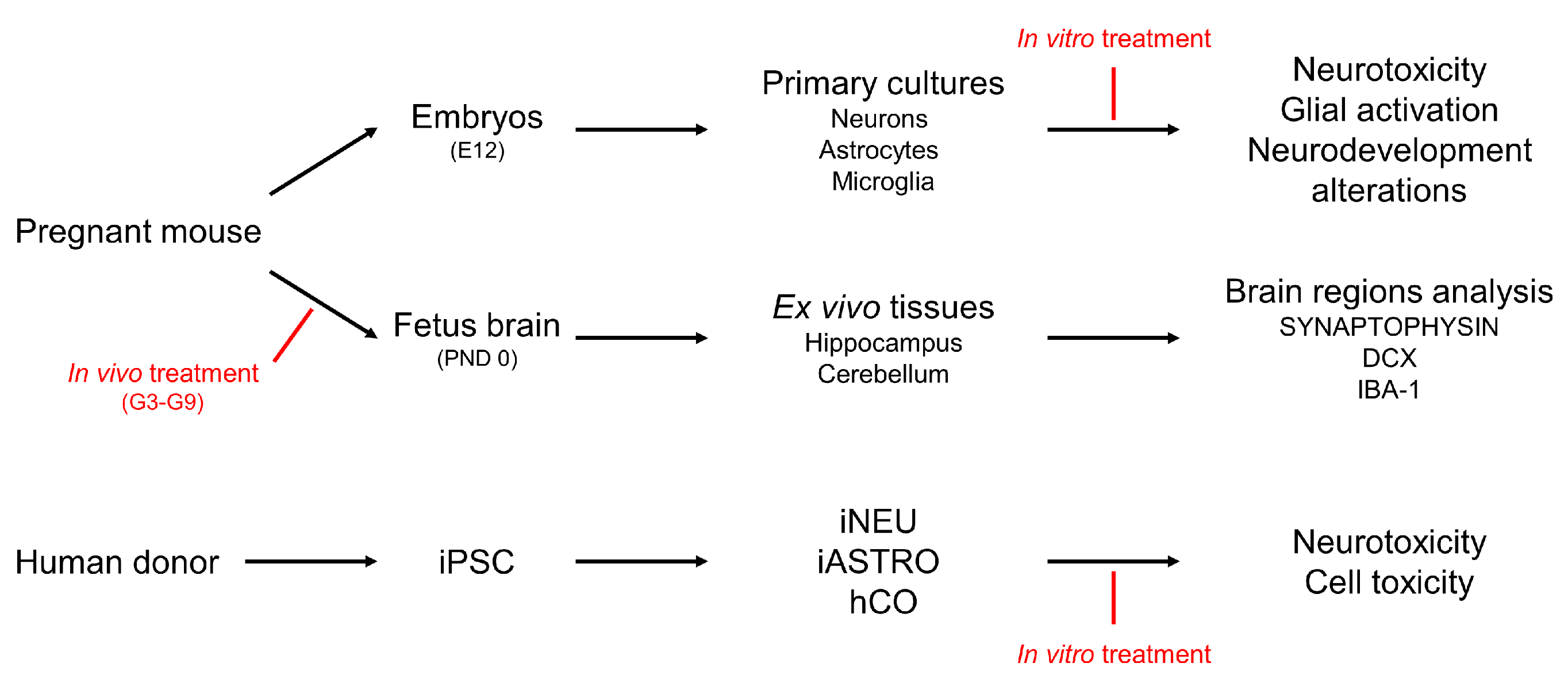
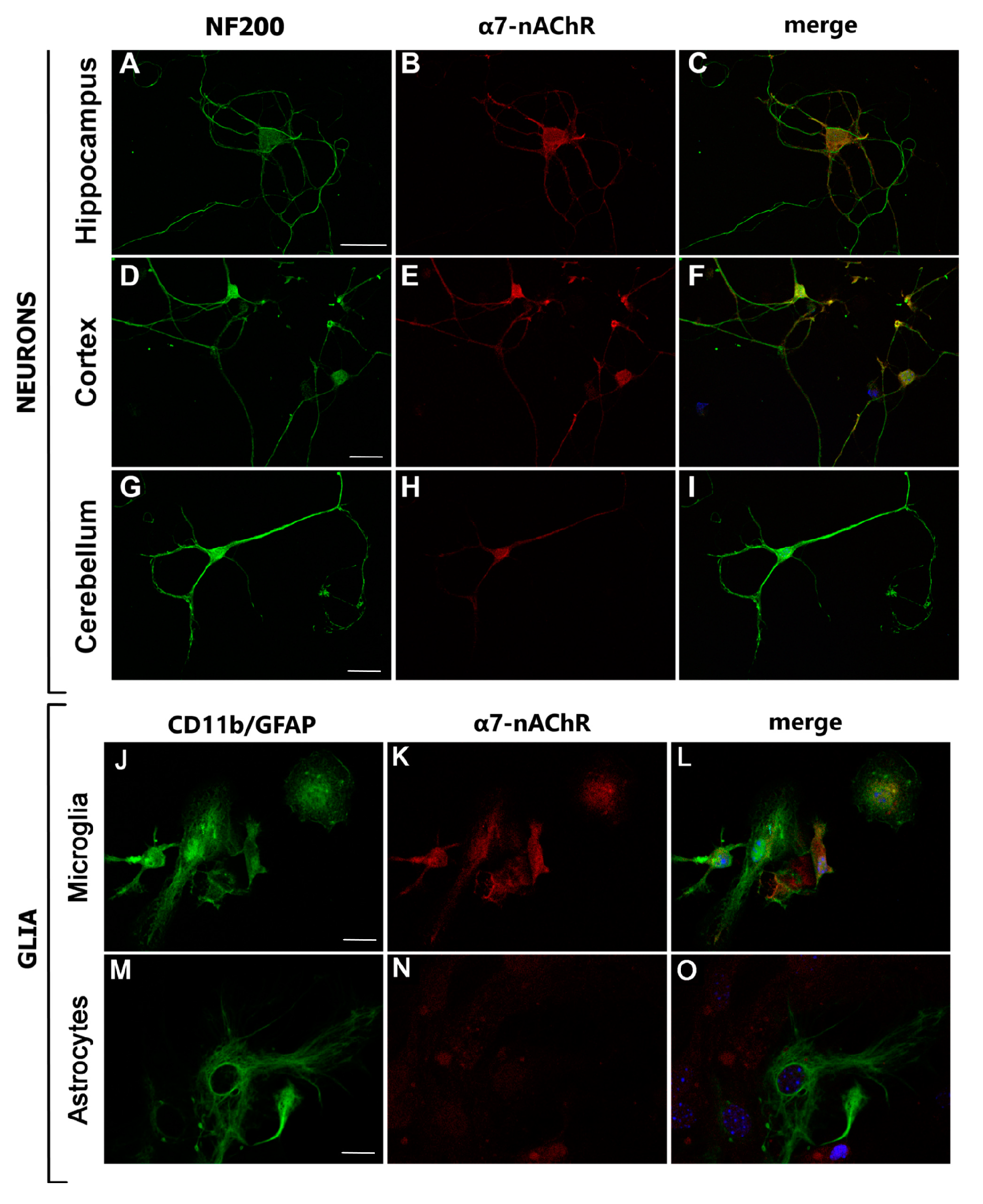
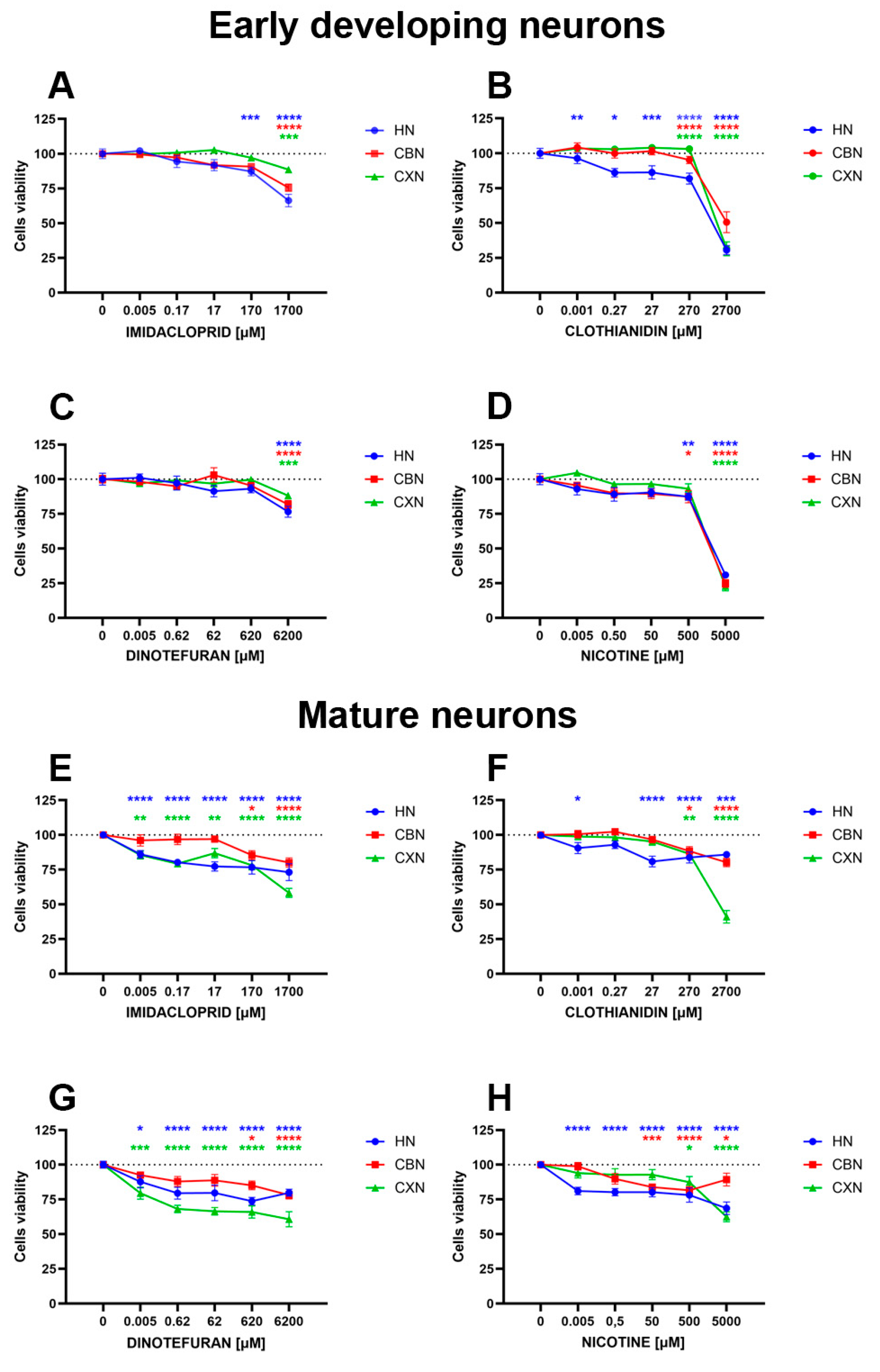
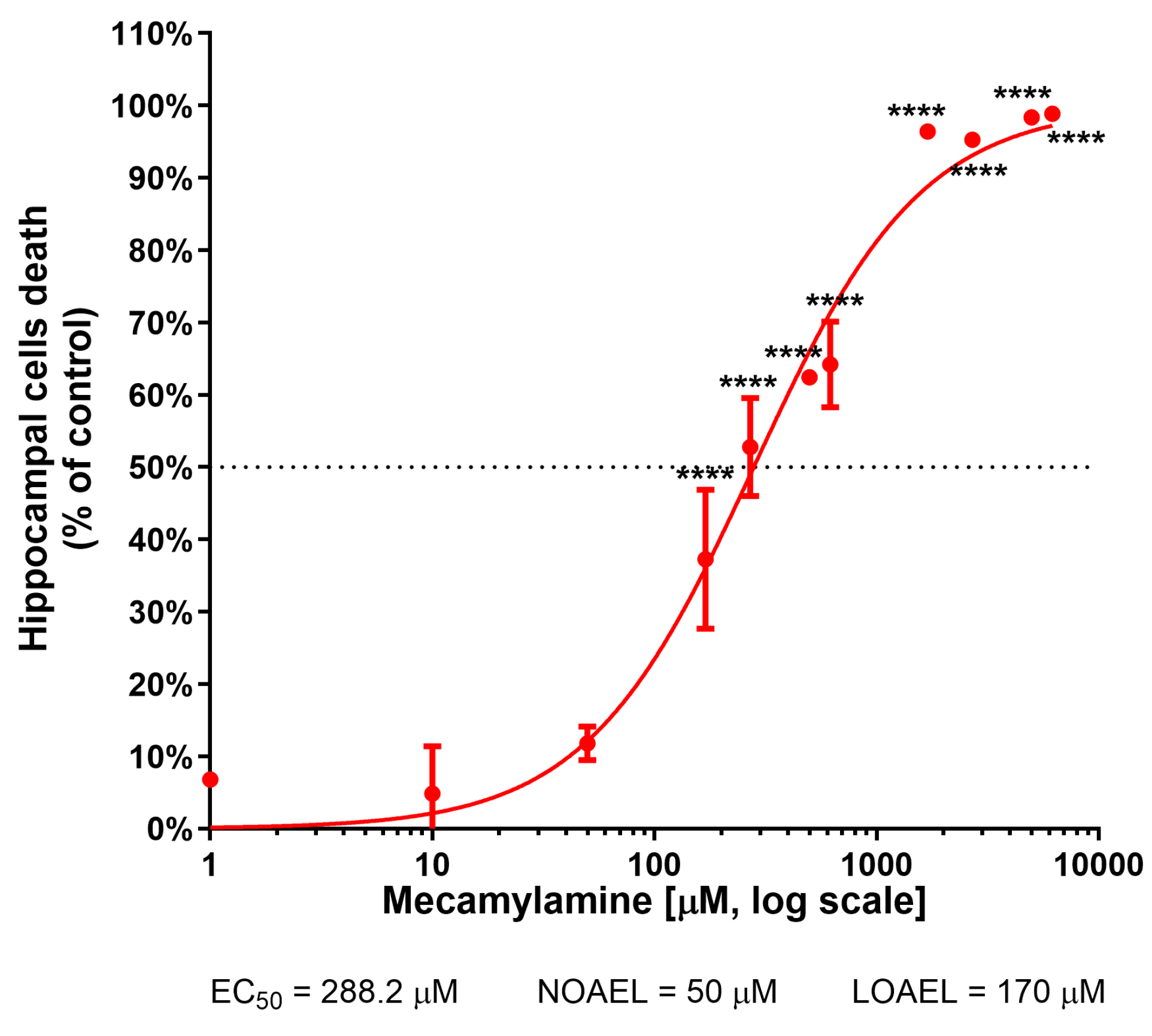
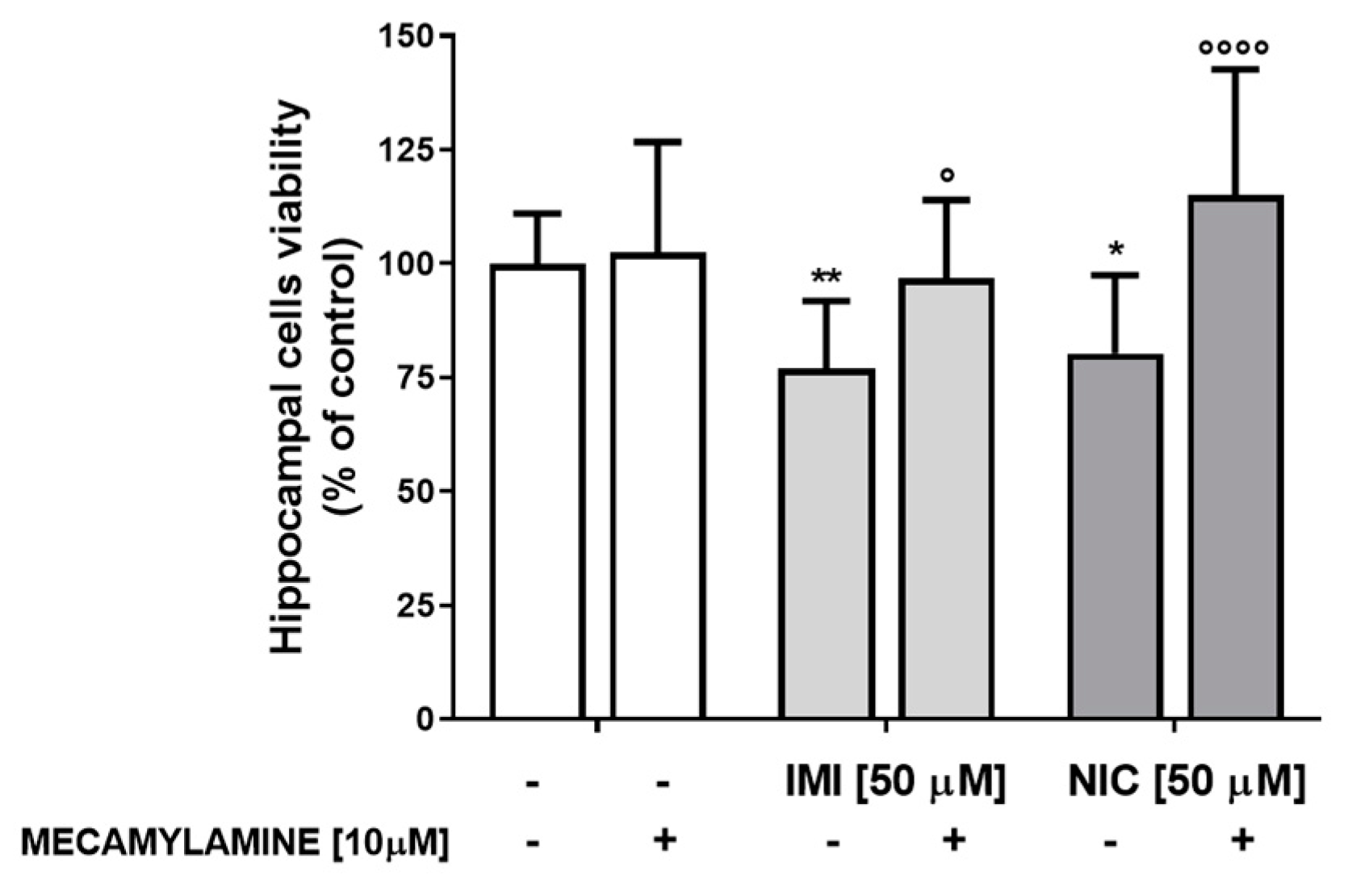

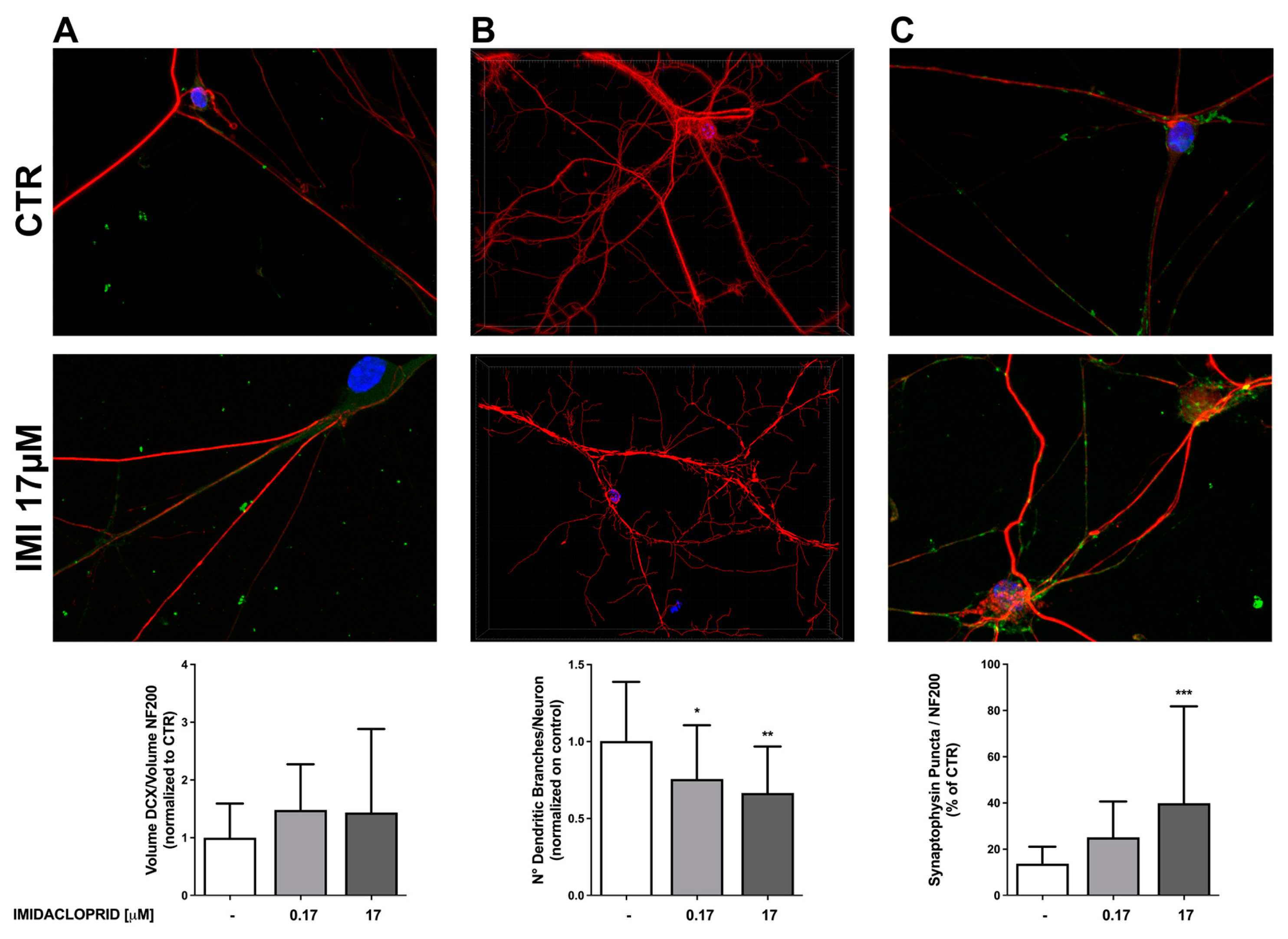
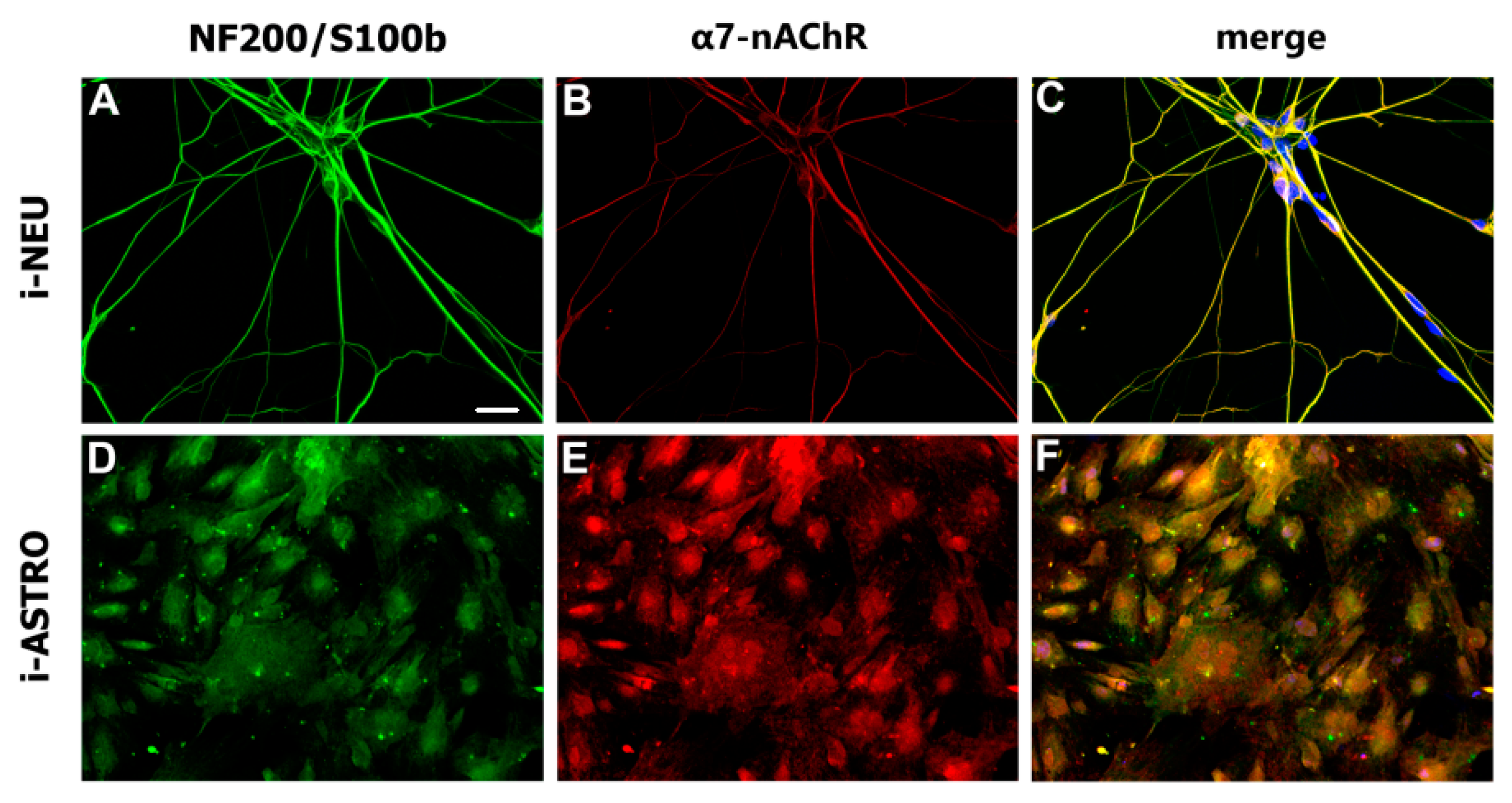

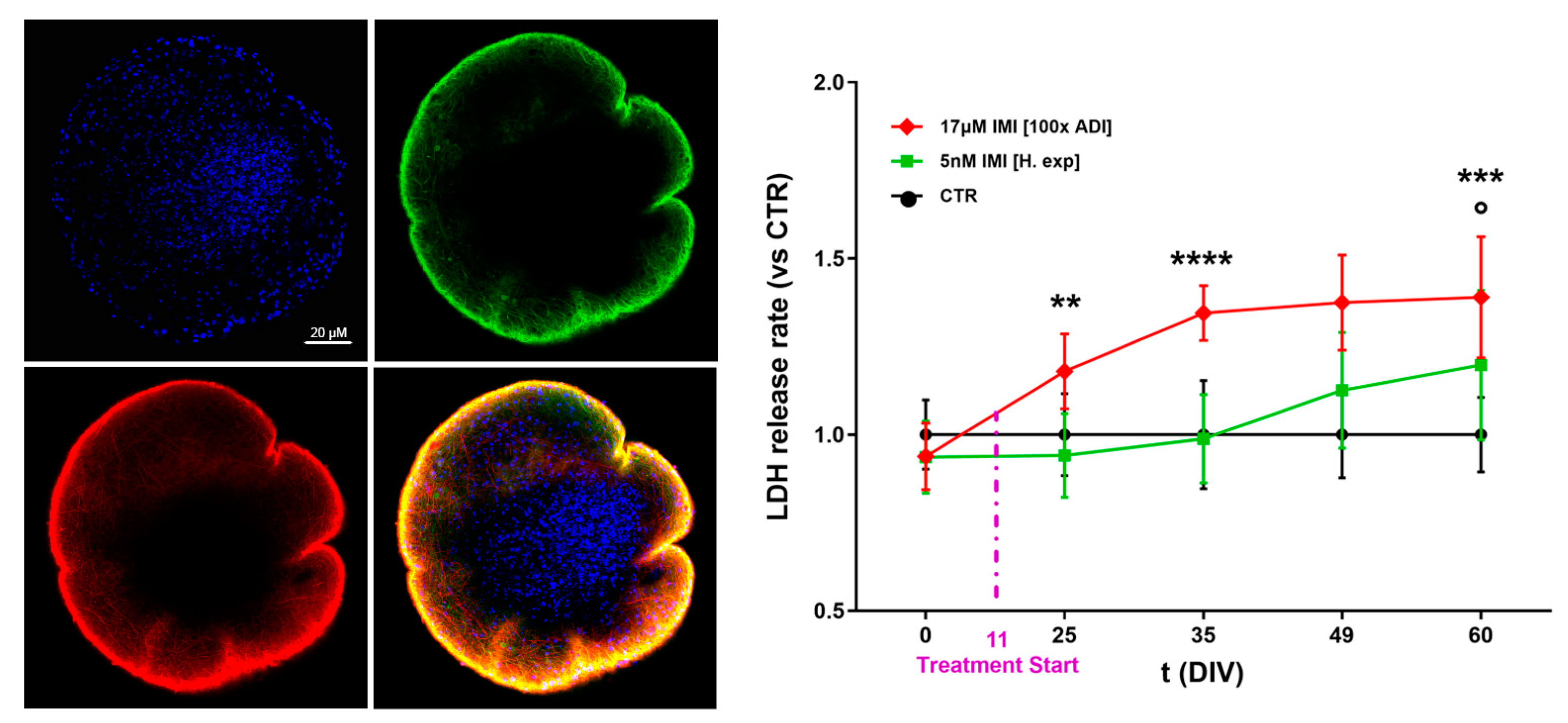
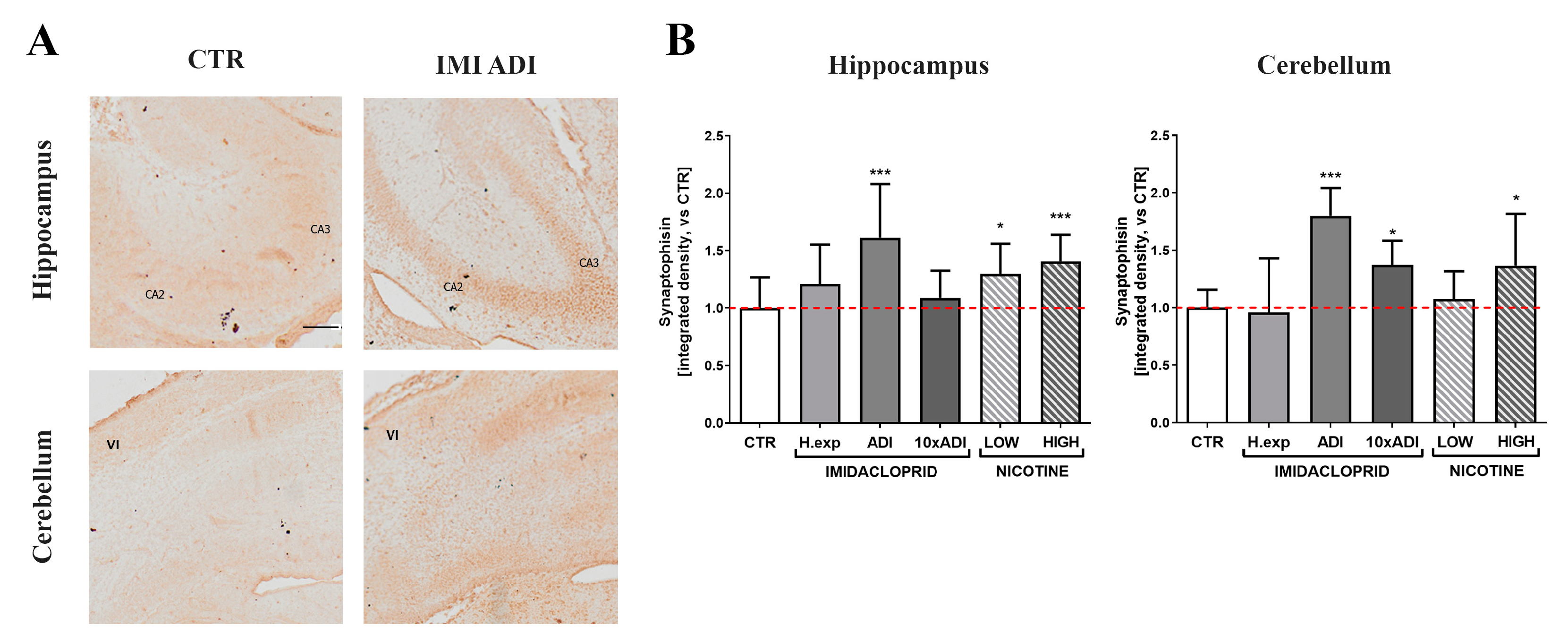


| In Vitro Doses | Estimated Daily Intake Women (13–49 Years) [µg/kg bw/day] | Estimated Fetal Brain Concentration eFBC [nM] | Acceptable Daily Intake ADI [µg/kg bw/day] | Admissible Fetal Brain Concentration aFBC [µM] | ||
| imidacloprid | 1.750 | [59] | 4.908 | 0.060 | [60] | 0.170 |
| clothianidin | 0.450 | [57] | 1.260 | 0.097 | [61] | 0.270 |
| dinotefuran | 1.900 | [58] | 5.320 | 0.220 | [62] | 0.620 |
| in vivo doses | Estimated intake women in pregnancy [mg/kg bw] | Experimental doses, single administartion H.exp. [mg/kg bw/inj] | Acceptable intake women in pregnancy [mg/kg bw] | Experimental doses, single administartion ADI [mg/kg bw/inj] | ||
| imidacloprid | 0.470 | [59] | 0.118 | 16.200 | [60] | 4.100 |
| clothianidin | 0.120 | [57] | 0.030 | 26.200 | [61] | 6.500 |
| dinotefuran | 0.510 | [58] | 0.128 | 59.400 | [62] | 14.900 |
| References | [59] California EPA Risk Characterization Document, 2006 | [60] EFSA Journal 2013;11(12):3471 | ||||
| [57] US EPA Registration Document, 2003 | [61] EFSA Journal 2010; 8(6):1647 | |||||
| [58] US EPA Registration Document, 2004 | [62] Food Safety Commission of Japan, 2013 | |||||
Disclaimer/Publisher’s Note: The statements, opinions and data contained in all publications are solely those of the individual author(s) and contributor(s) and not of MDPI and/or the editor(s). MDPI and/or the editor(s) disclaim responsibility for any injury to people or property resulting from any ideas, methods, instructions or products referred to in the content. |
© 2024 by the authors. Licensee MDPI, Basel, Switzerland. This article is an open access article distributed under the terms and conditions of the Creative Commons Attribution (CC BY) license (https://creativecommons.org/licenses/by/4.0/).
Share and Cite
Mariani, A.; Comolli, D.; Fanelli, R.; Forloni, G.; De Paola, M. Neonicotinoid Pesticides Affect Developing Neurons in Experimental Mouse Models and in Human Induced Pluripotent Stem Cell (iPSC)-Derived Neural Cultures and Organoids. Cells 2024, 13, 1295. https://doi.org/10.3390/cells13151295
Mariani A, Comolli D, Fanelli R, Forloni G, De Paola M. Neonicotinoid Pesticides Affect Developing Neurons in Experimental Mouse Models and in Human Induced Pluripotent Stem Cell (iPSC)-Derived Neural Cultures and Organoids. Cells. 2024; 13(15):1295. https://doi.org/10.3390/cells13151295
Chicago/Turabian StyleMariani, Alessandro, Davide Comolli, Roberto Fanelli, Gianluigi Forloni, and Massimiliano De Paola. 2024. "Neonicotinoid Pesticides Affect Developing Neurons in Experimental Mouse Models and in Human Induced Pluripotent Stem Cell (iPSC)-Derived Neural Cultures and Organoids" Cells 13, no. 15: 1295. https://doi.org/10.3390/cells13151295
APA StyleMariani, A., Comolli, D., Fanelli, R., Forloni, G., & De Paola, M. (2024). Neonicotinoid Pesticides Affect Developing Neurons in Experimental Mouse Models and in Human Induced Pluripotent Stem Cell (iPSC)-Derived Neural Cultures and Organoids. Cells, 13(15), 1295. https://doi.org/10.3390/cells13151295







